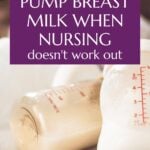This post may contain affiliate links to items I love, and I am confident you will too! All opinions are my own, however, I may receive a small commission on purchases. As an Amazon Associate I earn from qualifying purchases. For any health advice I give on nutrition and weight loss, make sure you check with your doctor, as I am not a health professional.
There are times when breastfeeding doesn’t work out for you and your new baby. Quite often, this is accompanied by a lot of guilt – especially for new moms. No need to worry, it’s not your fault.
Besides, there are other options available to help feed your baby with your natural breast milk. Most new moms have been told that breastfeeding ALWAYS works, and that it is an automatic process after childbirth, but sometimes it does not always go as planned and that’s fine!
Exclusive pumping is the next best option for new moms, if breastfeeding does not work out well. It applies to situations where your baby has to use extra effort to get breast milk, and it can be very relieving for both mommy and baby.
The hormones prolactin and oxytocin are responsible for the production of breast milk, but milk production is highly dependent on how quickly the breasts are emptied. If breast milk is left in the breast without being emptied, the breast milk production shuts down.
In situations where new moms are unable to breastfeed due to a serious medical history, pumping might not apply. It is very important to consult your physician for proper guidance if you have any breastfeeding concerns.
How to know when your baby is not getting sufficient breast milk?
It might be tough to understand how much milk your body produces with breastfeeding as you cannot directly see how much milk your baby is feeding on but, there are signs that reveal any problem with breastfeeding. They include:
Lots of crying:
If your baby is crying very often even after feeding, then it might not just be that they’re uncomfortable or tired. Your baby might not just be getting the right amount of breast milk.
No frequent wet diapers:
If your baby does not have up to 6-8 wet diapers in a day, it might mean there is a shortage in milk production for the baby.
No swollen breasts:
If you never feel your boobs fill or have them overfill, this is a big sign that your body is not producing a sufficient amount of milk for your baby.
Not finding milk in baby’s mouth:
If you don’t see any milk in your baby’s mouth right after they are done nursing, this is also another sign. This does not apply to colostrum, as it is lighter than real breast milk.
Baby is not swallowing:
This is the easiest way to find out if your baby is feeding well. You can have a look at your baby, and if your baby swallows after every 3-4 sucks, they are getting sufficient milk.
If breastfeeding is not an option for you as a new mom due to the requirement of so much effort to suckle by your baby, you can consider exclusive pumping for your baby. You might be lost in thoughts, wondering;
How does pumping increase my milk supply?
How to pump breast milk?
Do I have to pump breast milk all day?
What happens when I need to go back to work?
How do I bond with my baby through pumping?
When should I pump and for how long?
What is the best breast pump to use?
How to use a breast pump?
Is there a chance my baby can still breastfeed at all with pumping?
The thing with nursing a baby is, the more you panic, the worse the situation gets, so remember, the goal is a truly healthy, satisfied mom and baby irrespective of how it is achieved, so remember to keep calm for your new baby. Try to consult with an IBCLC, as they can help you out on a one on one basis. They can inspect the baby’s mouth, address your concerns, show you how best to express milk and also check for breast infections.
How does pumping increase my milk supply?
An average of pumping of 6-8 times a day, alongside frequent hand massages, stimulate the milk making glands to produce more breast milk.
How to pump breast milk?
Massage: This involves gently massaging the breasts before and after pumping. One study showed an increase in the volume of milk by 50% with gentle massages.
Double pumping: This is pumping both breasts at once. It is time conserving and can produce more milk. If you are pumping one breast at a time, it is advised to alternate every five minutes and repeat.
Do I have to pump breast milk all day?
No, you do not have to pump breast milk all day. The goal is to pump long enough to efficiently drain milk from the breast thereby, stimulating more production of milk by the milk making glands. This online course is terrific for giving you guidance on pumping: Ultimate Pumping Course.

What happens when I need to go back to work?
When you are ready to go back to work, you can store up milk little by little each day. Breast milk production is greater in the morning, so this might be the best time to pump. Milk pumped for your baby can be stored for when you are away from each other.
For more info and support as you get ready to go back to work, check out this online course from Milkology: Pumping for back to work. Also, check out this post with Tips and Must-Have Products for Pumping at Work.
How do I bond with my baby through pumping?
Talking, humming and singing with your bundle of joy during feeding sessions help your relationship grow closer and deeper
Give your baby full attention while feeding and don’t try to rush the process
Try a skin to skin connection by taking off or unbuttoning your shirt (Babies love it)
When should I pump and for how long?
Breast milk is produced based on a demand and supply chain. This implies that, the more you pump breast milk, the more the breast produces breast milk to meet that demand. Pumping for not less than 6-8 times a day is advised by medics, for moms who are looking to boost their milk production.
Simply put, pump as much milk as your baby should consume on a normal feeding pattern, this will enable your body to adjust to that amount of milk production. For how long you should pump, a study of mothers found a double pumping session with the inclusion of hand massages averaged 25 minutes, ranging from 15 minutes lowest to 45 minutes highest.
What is the best breast pump to use?
Different nursing moms require different pumps. All breast pumps achieve the same result, whether manual pumps, silicone pumps, electric pumps or hospital grade pumps. Some tips to guide you in choosing the most suitable pump for yourself includes:
Looking out for pumps with settings capable of allowing you more room to control and imitate a baby’s sucking pattern.
Considering pumps with proper flange fitting for nipple size
Deciding if you want a single pump or a double pump
Availability of substitute parts
Checking the online reviews for each brand
Second hand pumps may have working issues and hygiene worries
For exclusively pumping, which is when breastfeeding is not an option, double electric breast pumps or hospital grade pumps are the most effective.
How to use a breast pump?
The two variables on a pump include the pump suction, and the pump speed. It is usually recommended to use the most comfortable suction setting but not high enough to cause discomfort, as it might hinder milk flow.
Lastly, whether through breastfeeding, pumping or formula, what is important is having a healthy baby and a happy mommy, so don’t be worried mama, you’ve got this!




